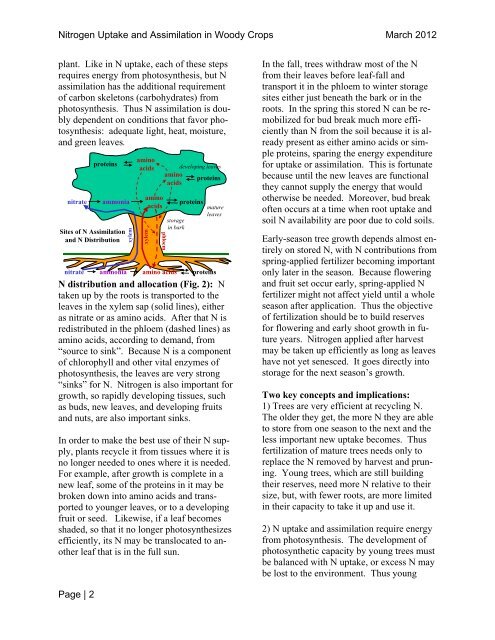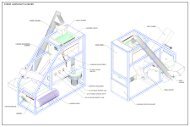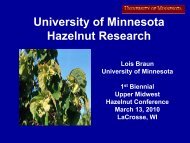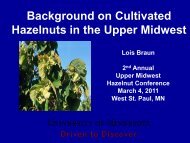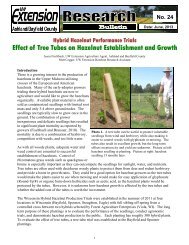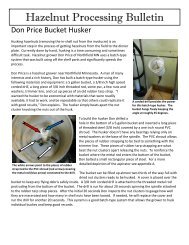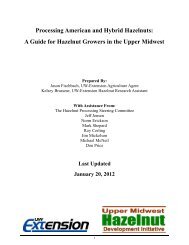Nitrogen Uptake and Assimilation - Upper Midwest Hazelnut ...
Nitrogen Uptake and Assimilation - Upper Midwest Hazelnut ...
Nitrogen Uptake and Assimilation - Upper Midwest Hazelnut ...
You also want an ePaper? Increase the reach of your titles
YUMPU automatically turns print PDFs into web optimized ePapers that Google loves.
xylem<br />
xylem<br />
<strong>Nitrogen</strong> <strong>Uptake</strong> <strong>and</strong> <strong>Assimilation</strong> in Woody Crops March 2012<br />
plant. Like in N uptake, each of these steps<br />
requires energy from photosynthesis, but N<br />
assimilation has the additional requirement<br />
of carbon skeletons (carbohydrates) from<br />
photosynthesis. Thus N assimilation is doubly<br />
dependent on conditions that favor photosynthesis:<br />
adequate light, heat, moisture,<br />
<strong>and</strong> green leaves.<br />
nitrate<br />
proteins<br />
ammonia<br />
Sites of N <strong>Assimilation</strong><br />
<strong>and</strong> N Distribution<br />
amino<br />
acids<br />
amino<br />
acids<br />
developing leaves<br />
amino<br />
proteins<br />
acids<br />
phloem<br />
storage<br />
in bark<br />
proteins<br />
mature<br />
leaves<br />
nitrate ammonia amino acids proteins<br />
N distribution <strong>and</strong> allocation (Fig. 2): N<br />
taken up by the roots is transported to the<br />
leaves in the xylem sap (solid lines), either<br />
as nitrate or as amino acids. After that N is<br />
redistributed in the phloem (dashed lines) as<br />
amino acids, according to dem<strong>and</strong>, from<br />
“source to sink”. Because N is a component<br />
of chlorophyll <strong>and</strong> other vital enzymes of<br />
photosynthesis, the leaves are very strong<br />
“sinks” for N. <strong>Nitrogen</strong> is also important for<br />
growth, so rapidly developing tissues, such<br />
as buds, new leaves, <strong>and</strong> developing fruits<br />
<strong>and</strong> nuts, are also important sinks.<br />
In order to make the best use of their N supply,<br />
plants recycle it from tissues where it is<br />
no longer needed to ones where it is needed.<br />
For example, after growth is complete in a<br />
new leaf, some of the proteins in it may be<br />
broken down into amino acids <strong>and</strong> transported<br />
to younger leaves, or to a developing<br />
fruit or seed. Likewise, if a leaf becomes<br />
shaded, so that it no longer photosynthesizes<br />
efficiently, its N may be translocated to another<br />
leaf that is in the full sun.<br />
In the fall, trees withdraw most of the N<br />
from their leaves before leaf-fall <strong>and</strong><br />
transport it in the phloem to winter storage<br />
sites either just beneath the bark or in the<br />
roots. In the spring this stored N can be remobilized<br />
for bud break much more efficiently<br />
than N from the soil because it is already<br />
present as either amino acids or simple<br />
proteins, sparing the energy expenditure<br />
for uptake or assimilation. This is fortunate<br />
because until the new leaves are functional<br />
they cannot supply the energy that would<br />
otherwise be needed. Moreover, bud break<br />
often occurs at a time when root uptake <strong>and</strong><br />
soil N availability are poor due to cold soils.<br />
Early-season tree growth depends almost entirely<br />
on stored N, with N contributions from<br />
spring-applied fertilizer becoming important<br />
only later in the season. Because flowering<br />
<strong>and</strong> fruit set occur early, spring-applied N<br />
fertilizer might not affect yield until a whole<br />
season after application. Thus the objective<br />
of fertilization should be to build reserves<br />
for flowering <strong>and</strong> early shoot growth in future<br />
years. <strong>Nitrogen</strong> applied after harvest<br />
may be taken up efficiently as long as leaves<br />
have not yet senesced. It goes directly into<br />
storage for the next season’s growth.<br />
Two key concepts <strong>and</strong> implications:<br />
1) Trees are very efficient at recycling N.<br />
The older they get, the more N they are able<br />
to store from one season to the next <strong>and</strong> the<br />
less important new uptake becomes. Thus<br />
fertilization of mature trees needs only to<br />
replace the N removed by harvest <strong>and</strong> pruning.<br />
Young trees, which are still building<br />
their reserves, need more N relative to their<br />
size, but, with fewer roots, are more limited<br />
in their capacity to take it up <strong>and</strong> use it.<br />
2) N uptake <strong>and</strong> assimilation require energy<br />
from photosynthesis. The development of<br />
photosynthetic capacity by young trees must<br />
be balanced with N uptake, or excess N may<br />
be lost to the environment. Thus young<br />
Page | 2


